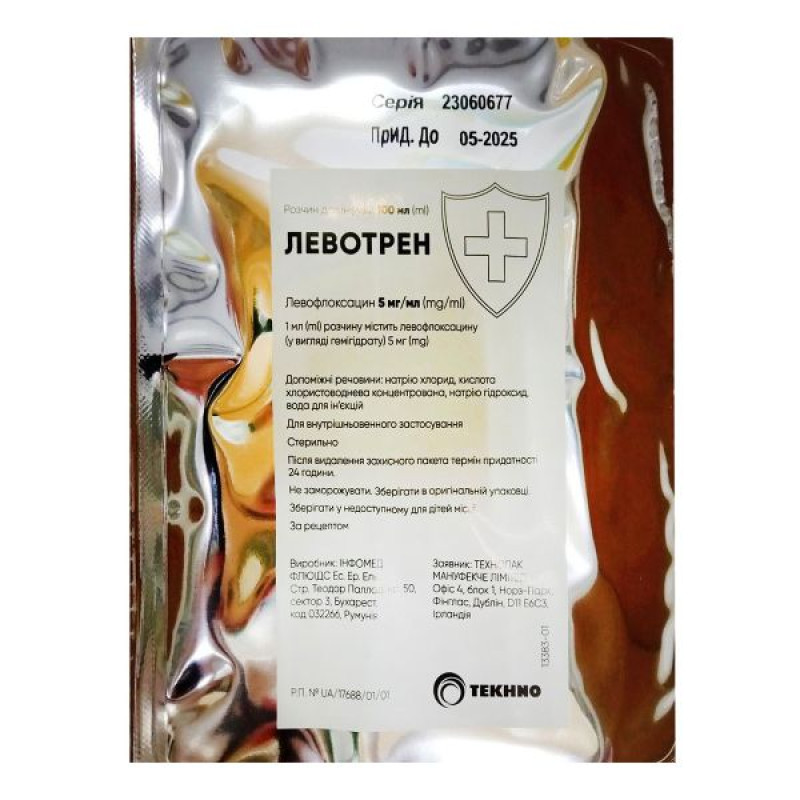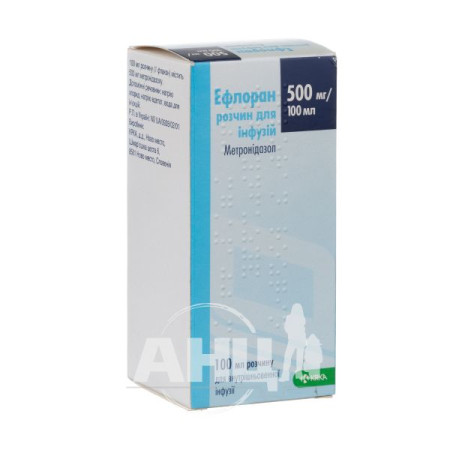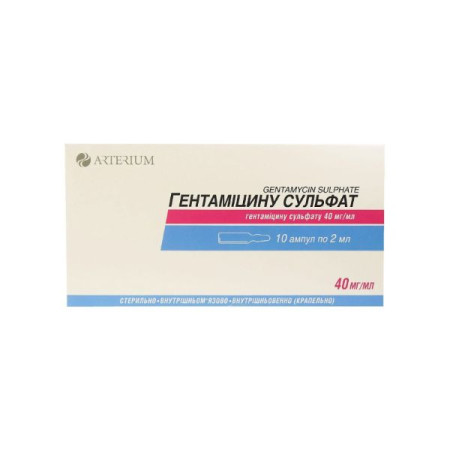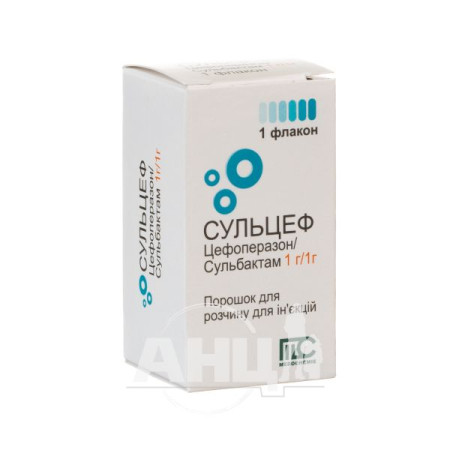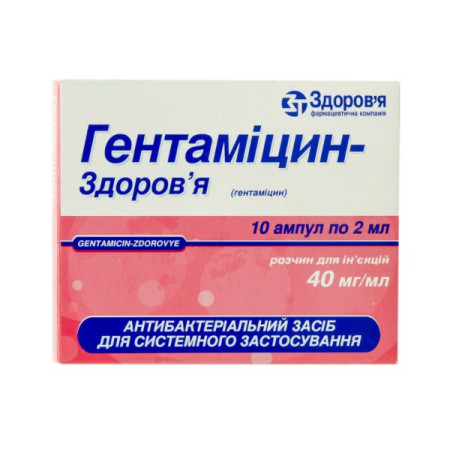Levotren solution for infusions 5 mg/ml 100 ml package No. 10 100 ml package No. 10
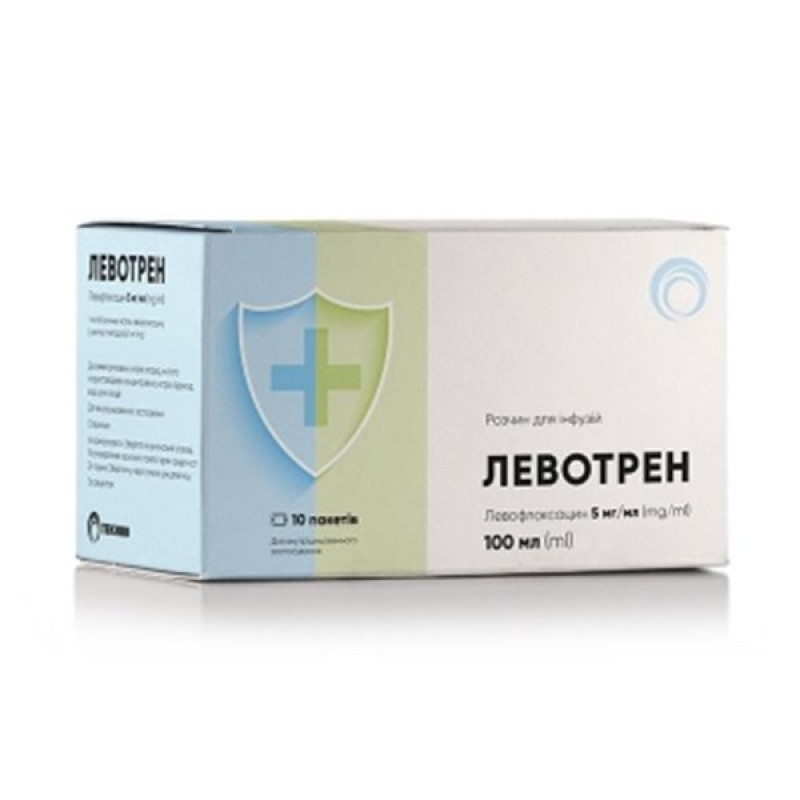
Instructions Levotren solution for infusions 5 mg/ml package 100 ml No. 10 package 100 ml No. 10
Composition
active ingredient: levofloxacin;
1 ml of solution contains levofloxacin (as hemihydrate) 5 mg;
Excipients: sodium chloride, concentrated hydrochloric acid, sodium hydroxide, water for injections.
Dosage form
Solution for infusion.
Main physicochemical properties: clear solution.
Pharmacotherapeutic group
Antibacterial agents for systemic use. Antibacterial agents of the quinolone group. Fluoroquinolones. ATX code J01MA12.
Pharmacological properties
Pharmacodynamics.
Levofloxacin is a synthetic antibacterial agent from the fluoroquinolone group, the S-enantiomer of the racemic mixture of the drug ofloxacin.
Mechanism of action. As an antibacterial drug from the fluoroquinolone group, levofloxacin acts on the DNA gyrase and topoisomerase IV complex.
Pharmacokinetics/pharmacodynamics relationship. The degree of bactericidal activity of levofloxacin depends on the ratio of the maximum serum concentration (Cmax) or area under the concentration-time curve (AUC) to the minimum inhibitory concentration [MIC (MIC)].
Mechanism of resistance: Resistance to levofloxacin develops through a stepwise process of mutation of the genes encoding both type II topoisomerases: DNA gyrase and topoisomerase IV. Other mechanisms of resistance, such as barrier penetration (characteristic of Pseudomonas aeruginosa) and efflux mechanisms, may also influence susceptibility to levofloxacin.
There is cross-resistance between levofloxacin and other fluoroquinolones.
Due to its mechanism of action, cross-resistance between levofloxacin and other classes of antibacterial agents is not usually observed.
Breakpoints. The recommended EUCAST (European Committee on Antimicrobial Susceptibility Testing) MIC breakpoints for levofloxacin, which distinguish susceptible from moderately susceptible (intermediately resistant) organisms and moderately susceptible from resistant organisms, are presented in the MIC testing table below (mg/L).
EUCAST clinical MIC breakpoints for levofloxacin (version 2.0, 2012-01-01):
| Pathogen | Sensitive | Resistant |
| Enterobacteriaceae | ≤ 1 mg/l | > 2 mg/l |
| Pseudomonas spp. | ≤ 1 mg/l | > 2 mg/l |
| Acinetobacter spp. | ≤ 1 mg/l | > 2 mg/l |
| Staphylococcus spp. | ≤ 1 mg/l | > 2 mg/l |
| S. pneumoniae 1 | ≤ 2 mg/l | > 2 mg/l |
| Streptococcus A, B, C and G | ≤ 1 mg/l | > 2 mg/l |
| H. influenzae 2.3 | ≤ 1 mg/l | > 1 mg/l |
| M. catarrhalis 3 | ≤ 1 mg/l | > 1 mg/l |
| Non-species related thresholds4 | ≤ 1 mg/l | > 2 mg/l |
1 Limit values are set for high-dose therapy. 2 Low-level resistance is possible (ciprofloxacin MIC 0.12–0.5 mg/L), but there is no evidence that it is of clinical significance for H. influenzae. 3 Strains with MIC values above the breakpoint between susceptible and moderately susceptible (intermediately resistant) strains are very rare or have not yet been reported. Identification and antimicrobial susceptibility testing on any such isolate should be repeated and, if confirmed, the isolate should be sent to an authorized laboratory. Isolates with confirmed MICs above the indicated resistance breakpoint are considered resistant until clinical response data are available. 4 Limit values for oral and intravenous doses are 500 mg 1–2 times a day. |
The prevalence of resistance of individual species may vary geographically and it is desirable to obtain local information on resistance over time, particularly when treating severe infections. Specialist advice should be sought when the local prevalence of resistance is such that the utility of the agent in at least some types of infections is questionable.
Typically sensitive species
Aerobic Gram-positive bacteria: Bacillus anthracis, methicillin-sensitive Staphylococcus aureus, Staphylococcus saprophyticus, Streptococci, group C and G, Streptococcus agalactiae, Streptococcus pneumoniae, Streptococcus pyogenes.
Aerobic gram-negative bacteria: Eikenella corrodens, Haemophilus influenzae, Haemophilus para-influenzae, Klebsiella oxytoca, Moraxella catarrhalis, Pasteurella multocida, Proteus vulgaris, Providencia rettgeri.
Anaerobic bacteria: Peptostreptococcus.
Others: Chlamydophila pneumoniae, Chlamydophila psittaci, Chlamydia trachomatis, Legionella pneumophila, Mycoplasma pneumoniae, Mycoplasma hominis, Ureaplasma urealyticum.
Species that may acquire resistance
Aerobic Gram-positive bacteria: Enterococcus faecalis, methicillin-resistant Staphylococcus aureus*, Coagulase negative Staphylococcus spp.
Aerobic gram-negative bacteria: Acinetobacter baumannii, Citrobacter freundii, Enterobacter aerogenes, Enterobacter cloacae, Escherichia coli, Klebsiella pneumoniae, Morganella morganii, Proteus mirabilis, Providencia stuartii, Pseudomonas aeruginosa, Serratia marcescens.
Anaerobic bacteria: Bacteroides fragilis.
Resistant strains
Aerobic Gram-positive strains: Enterococcus faecium
* Methicillin-resistant S. Aureus may be co-resistant to fluoroquinolones, including levofloxacin.
Pharmacokinetics.
Absorption
Food has a minor effect on the absorption of levofloxacin.
Steady state conditions are reached after one or two 500 mg injections according to the drug administration regimen for 48 hours.
Distribution
Approximately 30–40% of levofloxacin binds to serum proteins.
The mean volume of distribution of levofloxacin is approximately 100 L after single and repeated administration of a 500 mg dose, indicating its wide distribution into body tissues.
Penetration into tissues and body fluids
Levofloxacin penetrates well into bronchial mucosa, epithelial lining fluid, alveolar macrophages, lung tissue, skin (bladder fluid), prostate tissue, and urine. However, levofloxacin penetrates poorly into cerebrospinal fluid.
Biotransformation
Levofloxacin is metabolized to a minor extent, the metabolites being desmethyllevofloxacin and levofloxacin N-oxide. These metabolites account for less than 5% of the drug excreted in the urine. Levofloxacin is stereochemically stable and does not undergo inversion of the choral structure.
Breeding
After oral and intravenous administration, levofloxacin is eliminated from the blood plasma relatively slowly (half-life is 6–8 hours). It is excreted mainly by the kidneys (more than 85% of the administered dose). The mean apparent total clearance of levofloxacin after administration of a single 500 mg dose was 175 ± 29.2 ml/min. There is no significant difference in the pharmacokinetics of levofloxacin after intravenous and oral administration, which indicates that the oral and intravenous routes of administration are interchangeable.
Linearity
Levofloxacin has linear pharmacokinetics in the dose range of 50–1000 mg.
Patients with renal insufficiency
The pharmacokinetics of levofloxacin are affected by renal insufficiency. Renal excretion and clearance are reduced and half-lives are prolonged with decreased renal function, as shown in Table 1 below.
Table 1
| Creatinine clearance (ml/min) | < 20 | 20–40 | 50–80 |
| Renal clearance (ml/min) | 13 | 26 | 57 |
| Half-life (hours) | 35 | 27 | 9 |
Elderly patients
There are no significant differences in the pharmacokinetics of levofloxacin in young and elderly patients, except for differences related to creatinine clearance.
Gender differences
Separate analyses of male and female patients demonstrated slight gender differences in the pharmacokinetics of levofloxacin. There is no evidence that these gender differences in pharmacokinetics are clinically relevant.
Indication
Levotren, solution for infusion is indicated for the treatment of the following infectious diseases in adults:
community-acquired pneumonia;
complicated skin and soft tissue infections;
(with regard to the above infectious diseases, levofloxacin should be prescribed only in cases of insufficient effectiveness of other antibacterial drugs, which are mainly used for the initial treatment of these infections);
acute pyelonephritis and complicated urinary tract infections;
chronic bacterial prostatitis;
Pulmonary anthrax: post-exposure prophylaxis and radical treatment.
Official recommendations on the appropriate use of antibacterial agents should be considered.
Contraindication
Hypersensitivity to levofloxacin, to other quinolones or to any of the excipients of the drug;
epilepsy;
history of tendon damage when taking fluoroquinolones;
childhood (up to 18 years old);
pregnancy;
lactation period.
Interaction with other medicinal products and other types of interactions
The effect of other drugs on Levotren.
Theophylline, fenbufen or similar non-steroidal anti-inflammatory drugs. No pharmacokinetic interaction between levofloxacin and theophylline has been observed in clinical trials. However, a significant decrease in the seizure threshold may occur when quinolones are administered concomitantly with theophylline, non-steroidal anti-inflammatory drugs and other agents that lower the seizure threshold.
The concentration of levofloxacin in the presence of fenbufen increased by 13% compared to the concentration when levofloxacin was administered alone.
Probenecid and cimetidine: Probenecid and cimetidine had a statistically significant effect on the elimination of levofloxacin.
Renal clearance was reduced in the presence of cimetidine (24%) and probenecid (34%). This is because both drugs are capable of blocking the secretion of levofloxacin in the renal tubules. However, at the doses tested in the study, statistically significant kinetic differences are unlikely to be of clinical relevance.
Caution should be exercised when levofloxacin is used concomitantly with drugs that affect tubular secretion, such as probenecid and cimetidine, especially in patients with renal insufficiency.
Other medicinal products: Clinical pharmacology studies have not demonstrated a clinically significant effect on the pharmacokinetics of levofloxacin when levofloxacin is taken together with calcium carbonate, digoxin, glibenclamide, ranitidine.
The effect of Levotren on other drugs.
Vitamin K antagonists: Increased coagulation tests (prothrombin time/international normalized ratio) and/or bleeding, which may be severe, have been reported with concomitant use of vitamin K antagonists (e.g. warfarin). Therefore, coagulation parameters should be monitored in patients receiving concomitant vitamin K antagonists (see section 4.4).
Drugs that prolong the QT interval. Levofloxacin, like other fluoroquinolones, should be used with caution in patients receiving drugs that may prolong the QT interval (e.g. class IA and III antiarrhythmics, tricyclic antidepressants, macrolides, antipsychotics) (see section 4.4. QT interval prolongation).
Theophylline: In pharmacodynamic interaction studies, levofloxacin did not affect the pharmacokinetics of theophylline (a marker substrate of CYP1A2), indicating that levofloxacin does not inhibit CYP1A2.
Application features
Levofloxacin should be avoided in patients who have experienced serious adverse reactions in the past to drugs containing quinolones or fluoroquinolones (see section “Adverse reactions”). Treatment of these patients with levofloxacin should only be initiated in the absence of alternative treatment options and after a careful benefit/risk assessment (see section “Contraindications”). Long-term, disabling and potentially irreversible serious adverse drug reactions. Very rare cases of long-term (lasting months or years), disabling and potentially irreversible serious adverse drug reactions affecting various, sometimes multiple, body systems (musculoskeletal, nervous, psychotic and sensory) have been reported in patients taking quinolones and fluoroquinolones, regardless of age and pre-existing risk factors. Levofloxacin should be discontinued immediately at the first signs or symptoms of any serious adverse reactions and patients should seek advice from the specialist who prescribed the drug.
Methicillin-resistant S. aureus (MRSA) may be co-resistant to fluoroquinolones, including levofloxacin. Therefore, levofloxacin is not recommended for the treatment of known or suspected infections caused by MRSA unless laboratory results have confirmed susceptibility of the organism to levofloxacin (and antibacterial agents recommended for the treatment of MRSA infections are considered inappropriate).
Patients with severe cerebral atherosclerosis and cerebral circulation disorders should be careful when using the drug.
Fluoroquinolone resistance of E. coli, the most common cause of urinary tract infections, varies across the European Union. Prescribers are advised to take into account the local prevalence of fluoroquinolone resistance in E. coli.
Pulmonary anthrax: Recommendations for use in humans are based on in vitro susceptibility data of Bacillus anthracis, experimental data from animal studies, and limited human data. Physicians should refer to national and/or international consensus documents on the treatment of anthrax.
Duration of administration. The recommended duration of administration of the Levotren infusion solution should be observed, which is at least 60 minutes for 500 mg. It is known that tachycardia and a temporary decrease in blood pressure may occur during the infusion of ofloxacin. In rare cases, a sharp decrease in blood pressure, circulatory collapse may occur as a result. If a pronounced decrease in blood pressure is observed during the administration of levofloxacin (L-isomer of ofloxacin), the drug should be discontinued immediately.
Sodium content: This medicinal product contains 15.8 mmol (or 363 mg) sodium per 100 ml solution. Caution should be exercised when administering this medicinal product to patients on a controlled sodium diet.
Tendinitis and tendon ruptures. Tendinitis and tendon ruptures (including but not limited to the Achilles tendon), sometimes bilateral, may develop within 48 hours of starting treatment with levofloxacin, but have been reported up to several months after stopping treatment. The risk of tendinitis and tendon rupture is increased in patients over 60 years of age, in patients with impaired renal function, in patients receiving a daily dose of 1000 mg, in patients who have undergone transplantation and in patients taking corticosteroids. Therefore, the simultaneous use of levofloxacin and corticosteroids should be avoided.
At the first signs of tendinitis (inflammation, painful swelling), treatment should be discontinued and alternative treatments considered.
Appropriate treatment of the affected tendon (e.g. immobilization) should be initiated (see sections “Contraindications” and “Adverse Reactions”).
Clostridium difficile-associated disease. Diarrhoea, particularly severe, persistent and/or haemorrhagic, during or after treatment with levofloxacin (including several weeks after treatment) may be a symptom of Clostridium difficile-associated disease (CDAD). CDAD can range in severity from mild to life-threatening, with pseudomembranous colitis being the most severe (see section 4.8). It is therefore important to consider this diagnosis in patients who develop severe diarrhoea during or after treatment with levofloxacin. If CDAD is suspected, levofloxacin should be discontinued and appropriate treatment should be initiated immediately. Anti-motility agents are contraindicated in this clinical situation.
Patients prone to seizures. Quinolones may lower the seizure threshold and cause seizures. Levofloxacin is contraindicated in patients with epilepsy (see section “Contraindications”) and, like other quinolones, levofloxacin should be used with extreme caution in patients prone to seizures or in patients receiving concomitant therapy with active substances that lower the cerebral seizure threshold, such as theophylline (see section “Interaction with other medicinal products and other forms of interaction”). If a seizure occurs (see section “Adverse reactions”), levofloxacin treatment should be discontinued.
Patients with glucose-6-phosphate dehydrogenase deficiency. Patients with latent or present defects in glucose-6-phosphate dehydrogenase activity may be prone to hemolytic reactions when treated with quinolone antibacterial agents. Therefore, during treatment of such patients with levofloxacin, the patient's condition should be monitored for the occurrence of hemolysis.
Patients with renal insufficiency: Since levofloxacin is excreted primarily by the kidneys, dose adjustment is required in patients with impaired renal function (see section 4.2).
Hypersensitivity reactions: Levofloxacin may cause serious hypersensitivity reactions (e.g. angioedema up to anaphylactic shock) after the initial dose (see section 4.8). In such cases, patients should discontinue treatment immediately and consult a doctor.
Severe bullous reactions: Cases of severe bullous skin reactions, such as Stevens-Johnson syndrome and toxic epidermal necrolysis, have been reported with levofloxacin (see section 4.8). Patients should be advised to seek immediate medical attention before continuing treatment if skin and/or mucous membrane reactions occur.
Changes in blood glucose levels. Changes in blood glucose levels (hyperglycemia and hypoglycemia) have been reported with the use of quinolones, especially in diabetic patients receiving concomitant oral hypoglycemic agents (including glibenclamide) or insulin. Cases of hypoglycemic coma have been observed. Patients with diabetes should monitor their blood sugar levels (see section “Adverse reactions”).
Prevention of photosensitivity reactions: Photosensitivity reactions have been reported during treatment with levofloxacin (see section 4.8). Patients are advised to avoid sunlight and UV light (e.g., artificial ultraviolet lamps, solariums) while taking levofloxacin and for 48 hours after stopping treatment to prevent photosensitivity.
Patients receiving vitamin K antagonists. Due to the possibility of increased coagulation test values (PT/international normalized ratio) and/or bleeding in patients receiving levofloxacin in combination with a vitamin K antagonist (e.g. warfarin), coagulation test values should be monitored (see section “Interaction with other medicinal products and other forms of interaction”).
Psychotic reactions: Psychotic reactions have been reported in patients receiving quinolones, including levofloxacin. In very rare cases, these reactions have progressed to suicidal ideation and self-harm, sometimes after only a single dose of levofloxacin (see section 4.8). If a patient develops these reactions, levofloxacin should be discontinued and appropriate measures should be taken. Levofloxacin should be used with caution in patients with psychotic disorders and in patients with a history of psychiatric illness.
QT prolongation: Fluoroquinolones, including levofloxacin, should be used with caution in patients with risk factors for QT prolongation, such as:
congenital long QT syndrome;
concomitant use of drugs known to prolong the QT interval (e.g. class IA and III antiarrhythmics, tricyclic antidepressants, macrolides, antipsychotic drugs);
uncorrected electrolyte imbalance (e.g., hypokalemia, hypomagnesemia);
heart disease (e.g. heart failure, myocardial infarction, bradycardia).
Elderly patients and women may be more sensitive to drugs that prolong the QT interval. Therefore, fluoroquinolones, including levofloxacin, should be used with caution in this group of patients (see sections “Dosage and administration”, “Interaction with other medicinal products and other types of interactions”, “Adverse reactions”, “Overdose”).
Peripheral neuropathy: Cases of sensory or sensorimotor peripheral neuropathy resulting in paraesthesia, hypoesthesia, or dysesthesia have been reported in patients receiving fluoroquinolones, including levofloxacin. Patients receiving levofloxacin should be advised to inform their physician if they develop symptoms of neuropathy such as pain, burning, tingling, numbness, or weakness, and levofloxacin should be discontinued to prevent the development of an irreversible condition (see section 4.8).
Hepatobiliary disorders: Cases of necrotizing hepatitis, up to life-threatening hepatic failure, have been reported with levofloxacin, mainly in patients with severe underlying diseases such as sepsis (see section 4.8). Patients should be advised to discontinue treatment and seek medical advice if signs and symptoms of liver disease such as anorexia, jaundice, dark urine, pruritus or abdominal pain occur.
Exacerbation of myasthenia gravis. Fluoroquinolones, including levofloxacin, have neuromuscular blocking activity and may exacerbate muscle weakness in patients with myasthenia gravis. Serious adverse reactions, including fatalities and the need for mechanical ventilation, have been reported in the post-marketing setting with levofloxacin, which have been associated with the use of fluoroquinolones in patients with myasthenia gravis. Levofloxacin is not recommended for patients with a history of myasthenia gravis.
Visual disturbances. You should immediately consult an ophthalmologist if you develop any visual disturbances (see sections “Ability to influence the speed of reactions when driving vehicles or using other mechanisms” and “Adverse reactions”).
Superinfection: The use of levofloxacin, especially long-term, may lead to overgrowth of non-susceptible microorganisms. If superinfection develops during treatment, appropriate measures should be taken.
Opiates: False-positive urine tests for opiates may occur in patients receiving levofloxacin. Positive results for opiates may need to be confirmed by more specific methods.
Levofloxacin may inhibit the growth of Mycobacterium tuberculosis and therefore give a false-negative result in the bacteriological diagnosis of tuberculosis.
Use during pregnancy or breastfeeding
Pregnancy. There are limited data from the use of levofloxacin in pregnant women. Animal studies do not indicate direct or indirect reproductive toxicity. However, in the absence of human data and in the presence of experimental data indicating a risk of cartilage damage in the developing fetus due to fluoroquinolones, levofloxacin is contraindicated in pregnancy (see section 4.3).
Breastfeeding. Levofloxacin is contraindicated in breast-feeding women. There is insufficient information on the excretion of levofloxacin in breast milk. However, other fluoroquinolones are excreted in human milk. In the absence of human data and in the presence of experimental data indicating a risk of cartilage damage in the growing organism due to the action of fluoroquinolones, levofloxacin is contraindicated in breast-feeding women (see section “Contraindications”).
Fertility: Levofloxacin does not impair fertility or reproductive performance in animals.
Ability to influence reaction speed when driving vehicles or other mechanisms
Some undesirable effects, such as dizziness, drowsiness, visual disturbances, may impair patients' ability to concentrate and react and pose a risk in situations where this ability is of great importance (e.g. driving a car or operating machinery).
Method of administration and doses
The drug is administered intravenously 1–2 times a day.
The dose depends on the type and severity of the infection. The dosage recommendations for patients with normal renal function and creatinine clearance above 50 ml/min, as given in Table 2, should be followed.
Table 2
| Indication | Dose, mg | Number receptions per day | Duration of treatment |
|---|---|---|---|
| Community-acquired pneumonia | 500 | 1–2 times | 7–14 days |
| 500 | 1 time | 7–10 days | |
| Complicated urinary tract infections | 500 | 1 time | 7–14 days |
| Chronic bacterial prostatitis | 500* | 1 time | 28 days |
| Complicated skin and soft tissue infections | 500 | 1–2 times | 7–14 days |
*Depending on the patient's condition, after a few days it is possible to switch from intravenous administration of levofloxacin to oral administration with the same dosage.
Since levofloxacin is excreted primarily by the kidneys, the dose should be reduced in patients with impaired renal function.
Dosage for patients with renal impairment whose creatinine clearance is less than 50 mL/min is given in Table 3.
Table 3
| Creatinine clearance | Dosage regimen (depending on the severity of the infection and the nosological form) | ||
| 250 mg/ 24 hours | 500 mg/ 24 hours | 500 mg/ 12 hours | |
| 50–20 ml/min | first dose – 250 mg, the following – 125 mg/ 24 hours | first dose – 500 mg, the following – 250 mg/ 24 hours | first dose – 500 mg, the following – 250 mg/ 12 hours |
| 19–10 ml/min | first dose – 250 mg, the following – 125 mg/ 48 hours | first dose – 500 mg, the following – 125 mg/ 24 hours | first dose – 500 mg, the following – 125 mg/ 12 hours |
< 10 ml/min (also during hemodialysis) and HAPD)1 | first dose – 250 mg, the following – 125 mg/ 48 hours | first dose – 500 mg, the following – 125 mg/ 24 hours | first dose – 500 mg, the following – 125 mg/ 24 hours |
1 No additional doses are required after hemodialysis or chronic ambulatory peritoneal dialysis (CHAP).
Dosage for patients with impaired liver function: No dose adjustment is required since levofloxacin is metabolized to a minor extent in the liver.
Dosage for elderly patients: If renal function is not impaired, no dose adjustment is necessary.
The drug should be administered slowly intravenously by drip infusion.
The duration of administration should be at least 30 minutes for a 250 mg dose or at least 60 minutes for a 500 mg dose.
Depending on the patient's condition, after a few days it is possible to switch from intravenous administration to oral administration of levofloxacin with the same dosage.
The duration of treatment depends on the course of the disease. As with other antibacterial agents, it is recommended to continue treatment with the drug for at least 48–72 hours after normalization of body temperature or confirmed destruction of pathogens by microbiological tests.
Preparation of the drug for intravenous administration
hold the package port up;
unscrew the protective cap from the infusion port;
insert the drug needle into the infusion port with rotating movements;
Place the bag on the infusion solution stand.
During infusion, protection of the drug from light is not required.
From a microbiological point of view, the product should be used immediately. If not used, in-use stability times and conditions prior to use are the responsibility of the user.
Any unused solution or waste material should be disposed of in accordance with local requirements.
Mixing with infusion solutions.
The drug is compatible with the following infusion solutions: 0.9% sodium chloride solution, 5% glucose monohydrate, 2.5% glucose in Ringer's solution, multicomponent solutions for parenteral nutrition (amino acids, carbohydrates, electrolytes).
Children.
Levofloxacin is contraindicated for use in children, as damage to articular cartilage cannot be ruled out.
Overdose
Symptoms of overdose of the drug concern the central nervous system (CNS): confusion, dizziness, impaired consciousness and seizures. In the post-marketing period of use of levofloxacin, CNS effects, including confusion, seizures, hallucinations and tremor, have been observed.
Treatment is symptomatic. Due to possible prolongation of the QT interval, cardiac function should be monitored with an ECG. Hemodialysis, including peritoneal dialysis or HAPD, is not effective in removing levofloxacin from the body. There are no specific antidotes.
Side effects
Adverse reactions are described according to MedRA system organ classes, determined by frequency:
very common (≥ 1/10);
common (≥ 1/100, < 1/10);
uncommon (≥ 1/1000, ≤ 1/100);
rare (≥ 1/10,000, ≤ 1/1,000);
very rare (≤ 1/10,000);
unknown (cannot be estimated from available data).
Infections and infestations: Uncommon: fungal infections, including Candida species, overgrowth of other resistant organisms.
Blood and lymphatic system disorders: Uncommon: eosinophilia, leukopenia. Rare: thrombocytopenia, neutropenia. Not known: pancytopenia, agranulocytosis, haemolytic anaemia.
Gastrointestinal and metabolic disorders: Uncommon: anorexia. Rare: hypoglycaemia, especially in patients with diabetes mellitus (see section “Special warnings and precautions for use”). Not known: hyperglycaemia, hypoglycaemic coma (see section “Special warnings and precautions for use”).
Psychiatric disorders:* Common: insomnia Uncommon: anxiety, confusion, nervousness Rare: psychotic reactions (including hallucinations, paranoia), depression, agitation, nightmares Not known: psychotic disorders with self-harm, including suicidal thoughts or actions (see section 4.4).
Central nervous system: Common: headache, dizziness. Uncommon: drowsiness, tremor, dysgeusia. Rare: convulsions (see sections “Contraindications” and “Special warnings and precautions for use”), paresthesia. Not known: peripheral sensory neuropathy (see sections “Special warnings and precautions for use”), peripheral sensory motor neuropathy (see sections “Special warnings and precautions for use”), parosmia, including anosmia, dyskinesia, extrapyramidal disorders, ageusia, syncope, benign intracranial hypertension.
On the part of the organs of vision.* Rare: visual disturbances such as blurred vision (see section "Special instructions"). Not known: temporary loss of vision (see section "Special instructions").
Ear and labyrinth disorders* Uncommon: vertigo Rare: tinnitus Not known: hearing loss, hearing impairment.
Cardiovascular system: Rare: tachycardia, palpitations. Not known: ventricular tachycardia, which may lead to cardiac arrest, ventricular arrhythmia and torsade de pointes (predominantly in patients with risk factors for QT prolongation), electrocardiogram QT prolongation.
Vascular disorders: Common (only applies to the intravenous formulation): phlebitis. Rare: hypotension.
Respiratory, thoracic and mediastinal disorders: Uncommon: dyspnoea, bronchospasm, allergic pneumonitis.
Gastrointestinal disorders: Common: diarrhoea, vomiting, nausea. Uncommon: abdominal pain, dyspepsia, bloating, constipation. Not known: haemorrhagic diarrhoea, which may rarely be a sign of enterocolitis, including pseudomembranous colitis (see section 4.4), pancreatitis.
Hepatobiliary system: Common: increased liver enzymes (ALT/AST, alkaline phosphatase, GGTP). Uncommon: increased bilirubin. Not known: jaundice and severe liver damage, including acute fatal liver failure, predominantly in patients with severe underlying diseases (see section “Special warnings and precautions for use”). Hepatitis.
Skin and subcutaneous tissue disorders: Uncommon: rash, pruritus, urticaria, hyperhidrosis. Not known: toxic epidermal necrolysis, Stevens-Johnson syndrome, erythema multiforme, photosensitivity reactions (see section 4.4), leukocytoclastic vasculitis, stomatitis. Mucocutaneous reactions may sometimes occur even after the first dose.
Musculoskeletal system:* Uncommon: arthralgia, myalgia. Rare: tendon disorders (see sections “Contraindications” and “Special warnings and precautions for use”), including tendinitis (e.g. Achilles tendon), muscular weakness, especially in patients with myasthenia gravis (see section “Special warnings and precautions for use”). Not known: rhabdomyolysis, tendon rupture (e.g. Achilles tendon see sections
There are no reviews for this product.
There are no reviews for this product, be the first to leave your review.
No questions about this product, be the first and ask your question.



